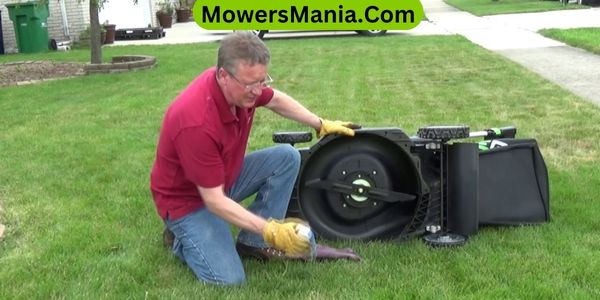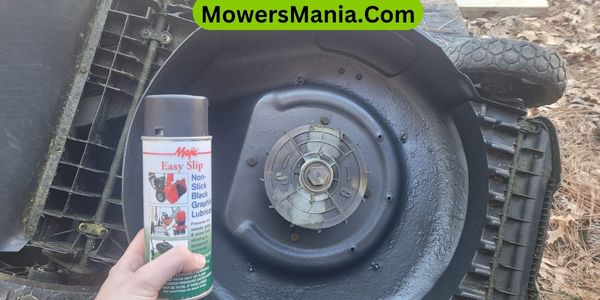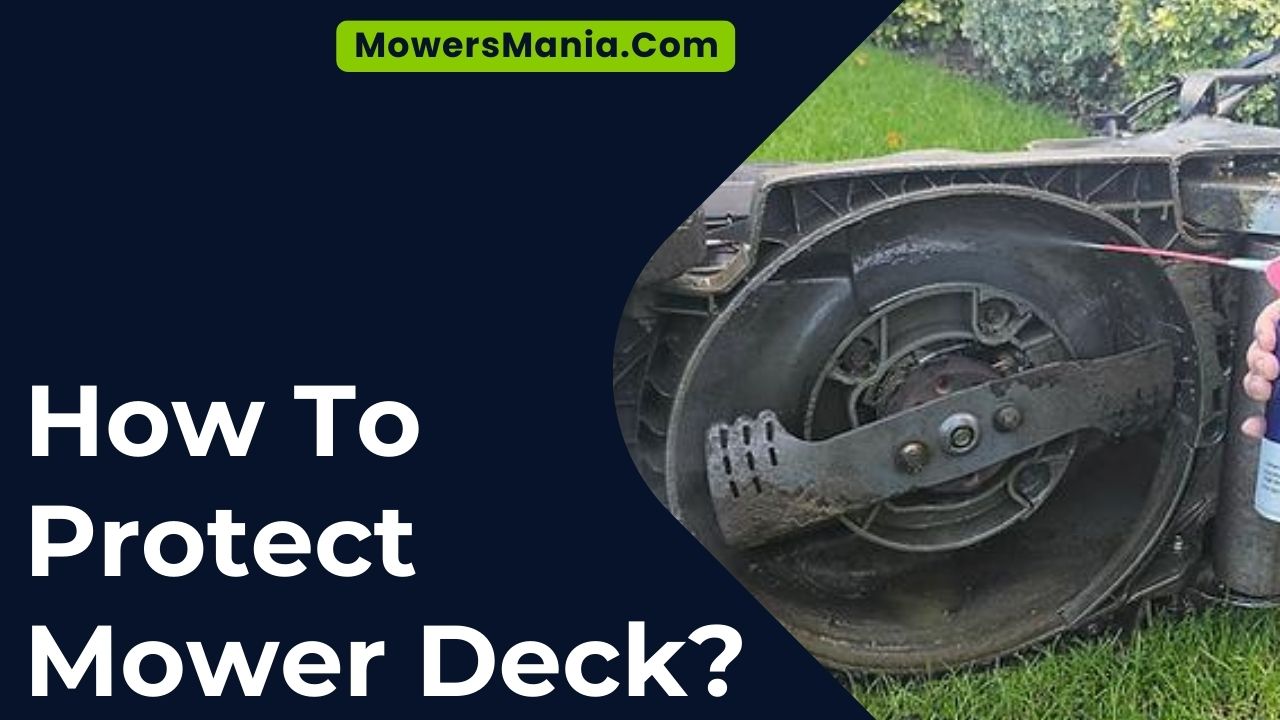You wouldn’t drive your car without changing the oil, right?
Well, the same goes for your mower deck. It’s the workhorse of your lawn care routine, and keeping it in top shape is crucial for a well-groomed yard.
From regular cleaning to applying a protective coating, taking care of your mower deck can ensure it lasts longer and performs better.

This guide will walk you through simple steps to protect your mower deck, so you can spend less time troubleshooting and more time enjoying your perfectly manicured lawn.
Let’s get started!
Regular Cleaning and Inspection
To keep your mower deck in good condition, you should regularly clean and inspect it for any signs of wear or damage. Start by removing any grass clippings, dirt, and debris that may have accumulated on the deck. Use a wire brush or putty knife to gently scrape off any caked-on grass or dirt.
Then, use a hose or pressure washer to thoroughly clean the deck, making sure to remove all remaining debris. Once the deck is clean, inspect it for any signs of wear, such as rust, cracks, or dents. Pay close attention to the blades, as they’re crucial for a clean cut.
If you notice any damage, make sure to address it promptly by either repairing or replacing the affected parts. Additionally, check the deck for loose or missing bolts, and tighten or replace them as needed.
Proper Storage and Shelter
When storing your mower, ensure that it is sheltered from the elements to prevent rust and deterioration.
Proper storage and shelter are crucial to maintaining the longevity of your mower deck. Exposure to rain, snow, and sunlight can lead to corrosion and damage, ultimately reducing the lifespan of your equipment.
Here are some important considerations for storing your mower:
| Shelter | Benefits | Tips |
|---|---|---|
| Garage or Shed | Protection from weather elements | Clear out space to accommodate the mower |
| Custom Mower Cover | Shields from rain, UV rays, and dust | Ensure the cover fits properly and is secure |
| Elevated Platform | Prevents moisture damage from the ground | Use a wooden pallet or platform for elevation |
Application of Protective Coating
When it comes to protecting your mower deck, selecting a suitable protective coating is crucial. You’ll want to ensure that the coating you choose is specifically designed to withstand the rigors of mowing and outdoor exposure.
Additionally, proper application techniques will be essential for achieving an effective and long-lasting protective layer.
Selecting Suitable Protective Coating
Before applying a protective coating to your mower deck, determine the type of coating suitable for your mower’s material and environmental conditions.
For steel mower decks, consider using an epoxy-based coating to provide a durable and corrosion-resistant layer.
Aluminum decks may benefit from a specialized aluminum-friendly protective coating to prevent oxidation and corrosion.
If your mower operates in a high-moisture or coastal environment, prioritize coatings with excellent moisture resistance to combat the effects of salt and humidity.
Additionally, for mowers used in areas with intense sunlight, UV-resistant coatings can help prevent sun damage and color fading.
Remember to thoroughly clean and prepare the mower deck surface before applying any protective coating to ensure maximum adhesion and effectiveness.
Proper Application Techniques
Properly applying the protective coating to your mower deck ensures long-lasting protection and durability.
Here are some key techniques to consider when applying the protective coating:
| Technique | Description |
|---|---|
| Surface Preparation | Clean the mower deck thoroughly to remove any dirt, rust, or old coatings. Ensure the surface is dry before applying the protective coating. |
| Application Method | Use a brush, roller, or sprayer to apply the protective coating evenly across the mower deck. Follow the manufacturer’s recommendations for the specific coating product. |
| Thin Coats | Apply thin, even coats of the protective coating to achieve better adhesion and durability. Avoid applying thick coats, as they may lead to uneven coverage and longer drying times. |
| Proper Drying Time | Allow sufficient drying time between coats as per the manufacturer’s instructions. Ensure the mower deck is completely dry and cured before use. |
Following these application techniques will help maximize the protective coating’s effectiveness and prolong the life of your mower deck.
Avoiding Moisture and Debris Buildup

To effectively protect your mower deck, regularly remove any moisture and debris buildup to prevent corrosion and damage. Moisture and debris can gather on the mower deck during use, especially in damp or rainy conditions, and if left unattended, can lead to rust and deterioration.
After each mowing session, take a few minutes to inspect the mower deck for any signs of moisture or debris accumulation.
Use a brush or blower to remove grass clippings, leaves, dirt, and any other debris that may have collected on the deck. Additionally, consider using a leaf blower or compressed air to thoroughly clean hard-to-reach areas.
After removing debris, wipe down the deck with a dry cloth to eliminate any remaining moisture. For more thorough cleaning, consider using a mild detergent and water to wash the deck, ensuring it’s completely dry before storage.
Maintenance of Cutting Blades
You should regularly sharpen your cutting blades to ensure a clean and efficient cut.
Additionally, applying a rust-preventative coating will help prolong the life of your blades and protect them from corrosion.
These simple maintenance tasks will keep your mower deck in top condition and ensure a professional-looking lawn.
Blade Sharpening Tips
To maintain sharp and efficient cutting blades, it’s essential to regularly sharpen them with a grinding stone or file, ensuring they remain effective in mowing your lawn.
Here are some blade sharpening tips to help you keep your mower in top condition:
- Take pride in the precision of your mower blades and enjoy the satisfaction of a perfectly manicured lawn.
- Appreciate the sense of achievement that comes with mastering the maintenance of your equipment.
- Feel the confidence of knowing that your mower is always ready to tackle the toughest grass with ease.
Remember, a well-maintained blade not only ensures a cleaner cut but also promotes the overall health of your lawn.
Rust Prevention Techniques
Regularly inspecting and cleaning your mower blades is crucial for preventing rust and maintaining their cutting efficiency. By doing this, you can ensure that your blades remain sharp and in top condition, allowing you to achieve a perfectly manicured lawn every time you mow.
To prevent rust, thoroughly clean the blades after each use, removing any grass clippings and debris. Apply a light coating of oil or a rust-preventative spray to the blades to create a protective barrier against moisture.
Additionally, store your mower in a dry, covered area when not in use to further prevent rust formation.
By incorporating these rust prevention techniques into your regular maintenance routine, you can prolong the life of your mower blades and ensure optimal cutting performance.
Monitoring and Addressing Wear and Tear

Keep an eye on the mower deck for signs of wear and tear, addressing any issues promptly to prevent further damage. Regular monitoring and proactive maintenance can extend the life of your mower deck and ensure optimal performance.
Here’s how to effectively monitor and address wear and tear:
- Listen for unusual noises: Pay attention to any unusual sounds coming from the mower deck, such as squeaking, grinding, or rattling. Addressing these noises promptly can prevent potential damage and costly repairs.
- Inspect for visible damage: Take the time to visually inspect the mower deck for any signs of wear, such as cracks, dents, or rust. Addressing these issues early can prevent them from escalating into more severe problems.
- Check for loose or worn-out parts: Ensure that all components of the mower deck are securely in place and free from excessive wear. Tighten any loose bolts or replace worn-out parts to prevent further damage and maintain the efficiency of the mower deck.
Frequently Asked Questions [FAQs]
Can I Use a Pressure Washer to Clean My Mower Deck, or Is That Too Harsh?
You can use a pressure washer to clean your mower deck, but be cautious. High pressure can damage the deck’s paint and cause rust. Use a wide-angle nozzle and keep the pressure low to effectively clean without causing harm.
Is It Necessary to Wax or Polish My Mower Deck After Applying a Protective Coating?
After applying a protective coating to your mower deck, it’s not necessary to wax or polish it. The protective coating should provide sufficient protection, but regular cleaning and maintenance will help it last longer.
How Often Should I Check for Moisture and Debris Buildup Under the Mower Deck?
You should check for moisture and debris buildup under the mower deck at least once a month. Regular inspection helps prevent corrosion and damage, ensuring your mower deck stays in good condition for longer.
Are There Any Specific Techniques for Sharpening Mower Blades That I Should Know About?
When sharpening mower blades, ensure they’re balanced and sharpened evenly. Use a file or grinder to remove nicks and create a sharp cutting edge. Wear gloves and eye protection, and always disconnect the spark plug before working on the blades.
What Are Some Signs of Wear and Tear on the Mower Deck That I Should Be Looking Out For?
Inspect the mower deck for cracks, rust, and dents. Check for uneven cutting patterns and unusual vibrations. Keep an eye out for loose or missing bolts. Regularly clean and lubricate the deck to prevent wear and tear.
Conclusion
Now that you know how to protect your mower deck, you can ensure its longevity and performance.
By regularly cleaning and inspecting, storing properly, applying protective coating, avoiding moisture and debris buildup, maintaining cutting blades, and addressing wear and tear, you can keep your mower deck in top condition.
With these simple steps, you can enjoy a well-maintained mower deck for years to come.



